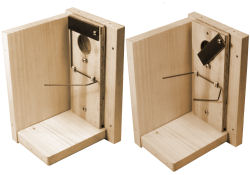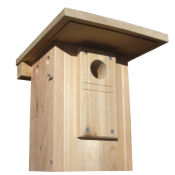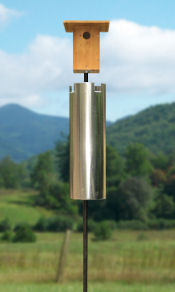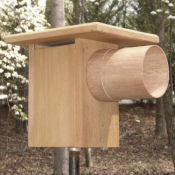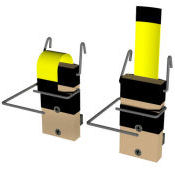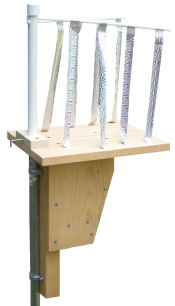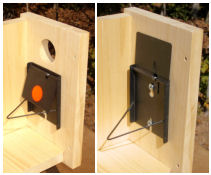
Every nest box, no matter how well conceived and built, is an artificial cavity provided by a human. Unlike natural cavities, nestboxes are extremely visible, making them easy targets for predators looking for a convenient meal. With that in mind, we must accept the responsibility to protect the future occupants of our nestboxes from intrusion by predators. There is no one solution to protect against all predators and unfortunately no solution is totally effective. When at all possible, know which predators you are dealing with and install the appropriate devices accordingly. Any device added to a box after egg laying has begun requires close follow-up observation to be sure both adults accept it.
How and where you mount your nestbox are two important predator controls you should not overlook. A nestbox nailed to a tree trunk, for example, provides climbing predators like raccoons, snakes, cats and ants easy access to a fast meal. Mount your nestbox on a metal pole.
Locate your nestbox away from undergrowth and brush. These areas provide cover for predators. A nestbox located near other structures or under overhanging limbs provide predators a path to your nestbox.
If you have a bird feeder, don't use a mix containing milo and millet. These small, BB sized seeds are a favorite food of House Sparrows. Replace with sunflower and/or safflower seeds. The desirable birds you want at your feeder actually prefer these seeds.
How and where you mount your nestbox are two important predator controls you should not overlook. A nestbox nailed to a tree trunk, for example, provides climbing predators like raccoons, snakes, cats and ants easy access to a fast meal. Mount your nestbox on a metal pole.
Locate your nestbox away from undergrowth and brush. These areas provide cover for predators. A nestbox located near other structures or under overhanging limbs provide predators a path to your nestbox.
If you have a bird feeder, don't use a mix containing milo and millet. These small, BB sized seeds are a favorite food of House Sparrows. Replace with sunflower and/or safflower seeds. The desirable birds you want at your feeder actually prefer these seeds.


Grease guard for conduit (left)
The top portion of a plastic bottle is secured to the pole with tape or a small screw. Grease is applied to the pole underneath the bottle.
The top portion of a plastic bottle is secured to the pole with tape or a small screw. Grease is applied to the pole underneath the bottle.
Predator Controls
Lorem ipsum dolor sit amet, consetetur sadipscing elitr, sed diam nonumy eirmod tempor invidunt ut labore et dolore magna aliquyam erat, sed diam voluptua. At vero eos et accusam et justo duo dolores et ea rebum. Stet clita kasd gubergren, no sea takimata sanctus est Lorem ipsum dolor sit amet. Lorem ipsum dolor sit amet, consetetur sadipscing elitr, sed diam nonumy eirmod tempor invidunt ut labore et dolore magna aliquyam erat, sed diam voluptua. At vero eos et accusam et justo duo dolores et ea rebum. Stet clita kasd gubergren, no sea takimata sanctus est Lorem ipsum dolor sit amet. Lorem ipsum dolor sit amet, consetetur sadipscing elitr, sed diam nonumy eirmod tempor invidunt ut labore et dolore magna aliquyam erat, sed diam voluptua. At vero eos et accusam et justo duo dolores et ea rebum. Stet clita kasd gubergren, no sea takimata sanctus est Lorem ipsum dolor sit amet.
Lorem ipsum dolor sit amet, consetetur sadipscing elitr, sed diam nonumy eirmod tempor invidunt ut labore et dolore magna aliquyam erat, sed diam voluptua. At vero eos et accusam et justo duo dolores et ea rebum. Stet clita kasd gubergren, no sea takimata sanctus est Lorem ipsum dolor sit amet. Lorem ipsum dolor sit amet, consetetur sadipscing elitr, sed diam nonumy eirmod tempor invidunt ut labore et dolore magna aliquyam erat, sed diam voluptua. At vero eos et accusam et justo duo dolores et ea rebum. Stet clita kasd gubergren, no sea takimata sanctus est Lorem ipsum dolor sit amet. Lorem ipsum dolor sit amet, consetetur sadipscing elitr, sed diam nonumy eirmod tempor invidunt ut labore et dolore magna aliquyam erat, sed diam voluptua. At vero eos et accusam et justo duo dolores et ea rebum. Stet clita kasd gubergren, no sea takimata sanctus est Lorem ipsum dolor sit amet.
Controlling Predators
by Virginia Daneke
by Virginia Daneke
Noel Guard
Constructed from 1/2" mesh hardware cloth, the Noel guard was designed to prevent raccoons and cats from reaching inside the cavity. This guard is typically used on boxes that have no other device to prevent climbing predators from reaching the box. Persistent raccoons may damage this guard, and may defeat it altogether if not securely installed.
Download plan 36.5kb (pdf)
Constructed from 1/2" mesh hardware cloth, the Noel guard was designed to prevent raccoons and cats from reaching inside the cavity. This guard is typically used on boxes that have no other device to prevent climbing predators from reaching the box. Persistent raccoons may damage this guard, and may defeat it altogether if not securely installed.
Download plan 36.5kb (pdf)
Hutchings Predator Guard
Same principle as Noel guard. Made from a 6" long section of 4" thin wall pvc and a pvc cap. Two entry holes of different diameters can be drilled in the cap for added versatility. Guard is attached to nestbox front with 3/4" wood screws. Designed by Don Hutchings.
The PVC guard at left has been stained to simulate woodgrain. See how to this in our Tips and Techniques section.
Download Plan
Same principle as Noel guard. Made from a 6" long section of 4" thin wall pvc and a pvc cap. Two entry holes of different diameters can be drilled in the cap for added versatility. Guard is attached to nestbox front with 3/4" wood screws. Designed by Don Hutchings.
The PVC guard at left has been stained to simulate woodgrain. See how to this in our Tips and Techniques section.
Download Plan
Van Ert Sparrow Trap
Installed inside box just below entry. To set, spring loaded top panel is engaged on the trigger arm. As bird enters the nestbox, it trips the arm, releasing the top panel which closes over the entry hole. When tripped, red dot on top panel shows through entry for distance visibility. Traps are available for both wood and pvc boxes from Van Ert Enterprises
Installed inside box just below entry. To set, spring loaded top panel is engaged on the trigger arm. As bird enters the nestbox, it trips the arm, releasing the top panel which closes over the entry hole. When tripped, red dot on top panel shows through entry for distance visibility. Traps are available for both wood and pvc boxes from Van Ert Enterprises
Wood Hole Guard
Used to increase the overall thickness of the entry, making it more difficult for avian predators to reach inside the nestbox cavity. Typically made from 3/4" to 1" thick wood. Does not deter raccoons. Can be used as an entry hole reducer.
Used to increase the overall thickness of the entry, making it more difficult for avian predators to reach inside the nestbox cavity. Typically made from 3/4" to 1" thick wood. Does not deter raccoons. Can be used as an entry hole reducer.
Metal Hole Guard
Used to prevent squirrels and woodpeckers from disfiguring or enlarging the entry. Can be installed on exterior or interior of box. Often used as a hole reducer for smaller bird species, such as chickadees, titmice and nuthatches.
Used to prevent squirrels and woodpeckers from disfiguring or enlarging the entry. Can be installed on exterior or interior of box. Often used as a hole reducer for smaller bird species, such as chickadees, titmice and nuthatches.
Hole guards
Sparrow traps - in box
The English House Sparrow is a primary reason for the decline of the Bluebird as well as the Purple Martin populations in North America. The House Sparrow is very aggressive and competes for nesting cavities. Not only does this displace the natives from chosen nesting sites, but when the natives leave their nest unattended, the sparrow will often enter the nest and destroy the eggs and/or kill the nestlings. If an adult Bluebird is unlucky enough to be caught in a nest box by a House Sparrow, the sparrow will use its powerful beak to peck a hole in its rival's skull thus killing it. The House Sparrow has done untold damage to the native populations of cavity nesters in North America. quoted from sparrowtraps.net
Important! Never leave a set trap unattended for more than an hour. Birds caught inside will die if not released promptly.
The English House Sparrow is a primary reason for the decline of the Bluebird as well as the Purple Martin populations in North America. The House Sparrow is very aggressive and competes for nesting cavities. Not only does this displace the natives from chosen nesting sites, but when the natives leave their nest unattended, the sparrow will often enter the nest and destroy the eggs and/or kill the nestlings. If an adult Bluebird is unlucky enough to be caught in a nest box by a House Sparrow, the sparrow will use its powerful beak to peck a hole in its rival's skull thus killing it. The House Sparrow has done untold damage to the native populations of cavity nesters in North America. quoted from sparrowtraps.net
Important! Never leave a set trap unattended for more than an hour. Birds caught inside will die if not released promptly.
Huber Sparrow Trap
Installed on plywood panel which is then installed in nestbox as shown. To set, metal plate is swiveled up and held in place with arming rod. As bird enters the nestbox it trips the arm, releasing the metal plate to fall down over the entry.
Download plan 231kb (pdf)
Installed on plywood panel which is then installed in nestbox as shown. To set, metal plate is swiveled up and held in place with arming rod. As bird enters the nestbox it trips the arm, releasing the metal plate to fall down over the entry.
Download plan 231kb (pdf)
It's not clear why House Sparrows in particular fear the reflective ribbons of the sparrow spooker, but most do, so this device has a fairly good success rate at deterring them. Spookers are easy to make with PVC pipe or dowels and streamers made of mylar, ribbon or strips from a potato chip bag.
Spookers are installed after the first egg is laid and removed immediately after the nestlings fledge. This schedule is important to prevent sparrows from becoming accustomed to the device.
Download plan: 145 kb (pdf)
Spookers are installed after the first egg is laid and removed immediately after the nestlings fledge. This schedule is important to prevent sparrows from becoming accustomed to the device.
Download plan: 145 kb (pdf)
Conical (Zeleny) Baffle
Conical baffles made of sheet metal will help deter squirrels, raccoons, cats and snakes. This type of baffle is useful if boxes are mounted on wooden posts and can be installed after a box is mounted. Raccoons may eventually learn their way around a conical baffle. Sharp edges require caution.
Plan available from Sialis.org
Conical baffles made of sheet metal will help deter squirrels, raccoons, cats and snakes. This type of baffle is useful if boxes are mounted on wooden posts and can be installed after a box is mounted. Raccoons may eventually learn their way around a conical baffle. Sharp edges require caution.
Plan available from Sialis.org
Baffles
Topics in this section
Baffles
Hole Guards
In-box traps
Ground traps
Sparrow spookers
Insect barriers
Baffles
Hole Guards
In-box traps
Ground traps
Sparrow spookers
Insect barriers
Wren Guards
The object of a wren guard is to hide the entrance hole from the House Wren (HOWR). Wren guards can be constructed from wood, paperboard or cardboard and installed after the first egg is laid. Guards can be equipped with sides which add even more protection by making the entrance harder to see. Whatever the material or style, guards should cover the hole with enough space between the guard and the front of the box to allow entrance by the adults. Bluebirds appreciate a 3" space; chickadees can use a 2.5" space; brown headed nuthatches can access the hole if the guard is as close as 1-1.5" due to their habit of crawling around on the box. Wren guards must be removed prior to fledging.
In some areas, HOWR pose little to no threat to the eggs and young of other species. In other places, HOWR routinely wreak havoc. One of the best strategies is to locate boxes a large distance (fifty yards) from HOWR habitat, avoiding brushy areas and dense tree growth. However, HOWR have been coming more out into the open in recent years and often protective measures can be useful.
Left photo (top) is a simple wren guard made from a wood panel.
Left photo (bottom) shows the "shoebox wren guard" made by cutting one long side from a shoebox. Attach with a row of thumbtacks. A light coat of latex paint allows it to stand up to a little weather.
The object of a wren guard is to hide the entrance hole from the House Wren (HOWR). Wren guards can be constructed from wood, paperboard or cardboard and installed after the first egg is laid. Guards can be equipped with sides which add even more protection by making the entrance harder to see. Whatever the material or style, guards should cover the hole with enough space between the guard and the front of the box to allow entrance by the adults. Bluebirds appreciate a 3" space; chickadees can use a 2.5" space; brown headed nuthatches can access the hole if the guard is as close as 1-1.5" due to their habit of crawling around on the box. Wren guards must be removed prior to fledging.
In some areas, HOWR pose little to no threat to the eggs and young of other species. In other places, HOWR routinely wreak havoc. One of the best strategies is to locate boxes a large distance (fifty yards) from HOWR habitat, avoiding brushy areas and dense tree growth. However, HOWR have been coming more out into the open in recent years and often protective measures can be useful.
Left photo (top) is a simple wren guard made from a wood panel.
Left photo (bottom) shows the "shoebox wren guard" made by cutting one long side from a shoebox. Attach with a row of thumbtacks. A light coat of latex paint allows it to stand up to a little weather.
Stovepipe Baffle
The stovepipe baffle is the most effective defense against climbing predators such as raccoons, cats, rats, mice, squirrels and snakes. As raccoons are the largest ground predator likely to attack an occupied box, a baffle meant to deter squirrels is not large enough. This type of baffle should be installed before mounting the box on the pole. If the top is solid, soap should be applied inside the top and part of the way down the sides to deter wasps from building nests.
Pictured at left is the Kingston baffle, made from 8" diameter stovepipe.
Designed by Ron Kingston.
Download plan: 100kb (pdf)
The stovepipe baffle is the most effective defense against climbing predators such as raccoons, cats, rats, mice, squirrels and snakes. As raccoons are the largest ground predator likely to attack an occupied box, a baffle meant to deter squirrels is not large enough. This type of baffle should be installed before mounting the box on the pole. If the top is solid, soap should be applied inside the top and part of the way down the sides to deter wasps from building nests.
Pictured at left is the Kingston baffle, made from 8" diameter stovepipe.
Designed by Ron Kingston.
Download plan: 100kb (pdf)
Sparrow traps - ground
Grease
Grease, if routinely applied, is an effective deterrent for ants and other ground dwelling insects. Care should be taken, however, to avoid the possibility of birds contacting it.
Exposed grease will collect dirt, trap beneficial insects, and soil your clothing and hands. But worst of all the sticky stuff endangers the birds we're trying to help. Grease on a bird's feathers will reduce insulation value, subjecting the bird to hypothermia. Flight can be impaired, making the bird more vulnerable to predation.
The best location for grease is on the mounting pole inside a predator baffle. If you are using polished and waxed conduit with no baffle, you can make a "grease guard" from a plastic bottle. The bottle is held in place by wrapping tape on the pole or you can secure it with a small screw. Apply the grease to the pole so the bottle will completely cover it. For hanging boxes, a bottle cap, held in place with tape, can be used in the same manner.
Grease, if routinely applied, is an effective deterrent for ants and other ground dwelling insects. Care should be taken, however, to avoid the possibility of birds contacting it.
Exposed grease will collect dirt, trap beneficial insects, and soil your clothing and hands. But worst of all the sticky stuff endangers the birds we're trying to help. Grease on a bird's feathers will reduce insulation value, subjecting the bird to hypothermia. Flight can be impaired, making the bird more vulnerable to predation.
The best location for grease is on the mounting pole inside a predator baffle. If you are using polished and waxed conduit with no baffle, you can make a "grease guard" from a plastic bottle. The bottle is held in place by wrapping tape on the pole or you can secure it with a small screw. Apply the grease to the pole so the bottle will completely cover it. For hanging boxes, a bottle cap, held in place with tape, can be used in the same manner.
Insect barriers
Home | Site Map | Disclaimer | Contact Us
Copyright © 2012 NestboxBuilder.com
This site was last updated on 01/01/2016
Copyright © 2012 NestboxBuilder.com
This site was last updated on 01/01/2016
Predator Control Devices
Please remember! In using any bird trap, it is imperative that the trap be monitored at least once daily so that any native species can be immediately released, and that House Sparrows to be kept as decoys are provided a source of food and water. There are several species of sparrows native to North America as well. While the male House Sparrow is quite distinctive and easy to identify, the female may be harder to identify. Please get a field guide to assist in your identification. And if there's any doubt, let it out! It is much better to mistakenly allow a House Sparrow to live another day than to mistakenly destroy a native bird. - from sparrowtraps.net
Sparrow spooker
Ground traps are capable of capturing multiple birds. They are indispensible tools when sparrows or starlings invade your habitat in large numbers.
Read more about these traps at sparrowtraps.net
Read more about these traps at sparrowtraps.net
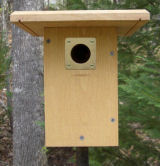
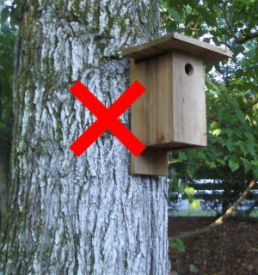
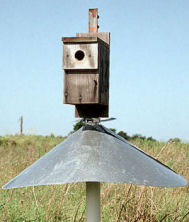
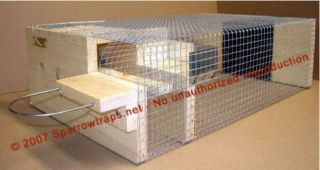
Don't turn your nestbox into a fast food restaurant for climbing predators.
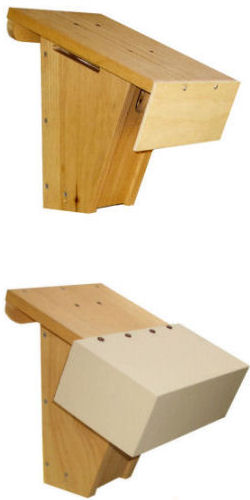
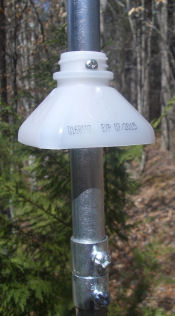
For Hanging Boxes:
1. Wrap tape around hanging wire to provide a stop for the bottle cap. Space the tape so the bottle cap will be about 2" above the roof.
2. Apply grease to hanging wire at the top of the tape.
3. Slide bottle cap down to cover grease. Clean any exposed grease.
1. Wrap tape around hanging wire to provide a stop for the bottle cap. Space the tape so the bottle cap will be about 2" above the roof.
2. Apply grease to hanging wire at the top of the tape.
3. Slide bottle cap down to cover grease. Clean any exposed grease.
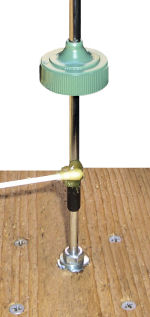
Grease applied to the pole underneath the baffle will prevent accidental contact by birds.
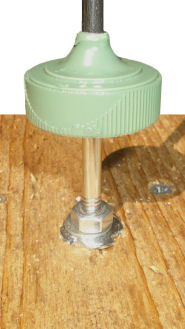
Gilbertson Universal Sparrow Trap
Installed inside box just below entry. Metal band made from piece of retractable tape measure is bent down to engage wire retaining arm. When bird enters nestbox it trips arm, releasing the band which closes over the entry hole. Trap works on both wood and pvc boxes.
Download plan: 230kb (pdf)
Installed inside box just below entry. Metal band made from piece of retractable tape measure is bent down to engage wire retaining arm. When bird enters nestbox it trips arm, releasing the band which closes over the entry hole. Trap works on both wood and pvc boxes.
Download plan: 230kb (pdf)
